
A Survey of Public VRtractions
Extended from original article published in Presence 3(1), Winter '94
Michael Cohen
Spatial Media Group
Human Interface Lab.
University of Aizu 965-8580
Japan
voice: [+81](242)37-2537
fax: [+81](242)37-2549
e-mail: mcohen@u-aizu.ac.jp
www: http://www.u-aizu.ac.jp/~mcohen
Tokyo offers a spectrum of special theatres that are mounted on powerful hydraulic lifts, capable of suddenly swinging the entire auditorium up to a meter or so in each direction. Like Disneyland's "Star Tours" or more advanced (inertial effects) "Body Tours" attractions, these motion platforms can be synchronized with image and sound, literally moving the audience, imparting a sensation of real movement. Typically flattering the effects, rather than emphasizing the plot, these tend to be short, perhaps thankfully, since some virtual travelers report yoi, simulation sickness.
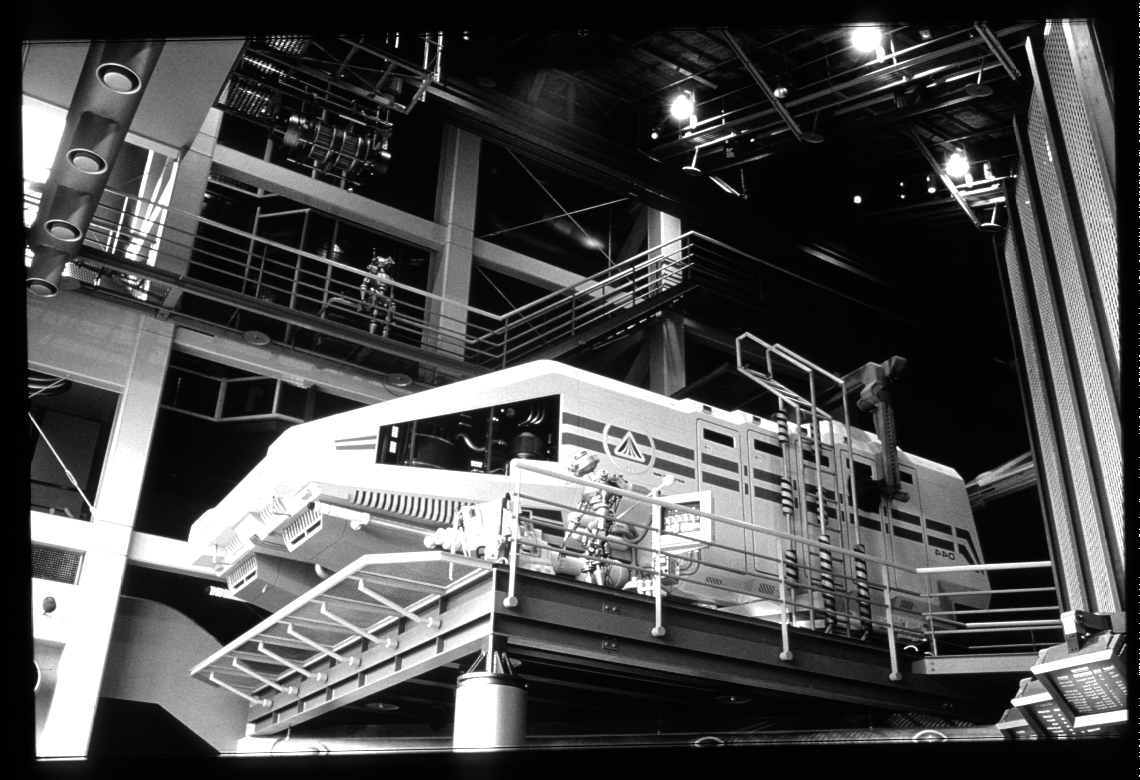
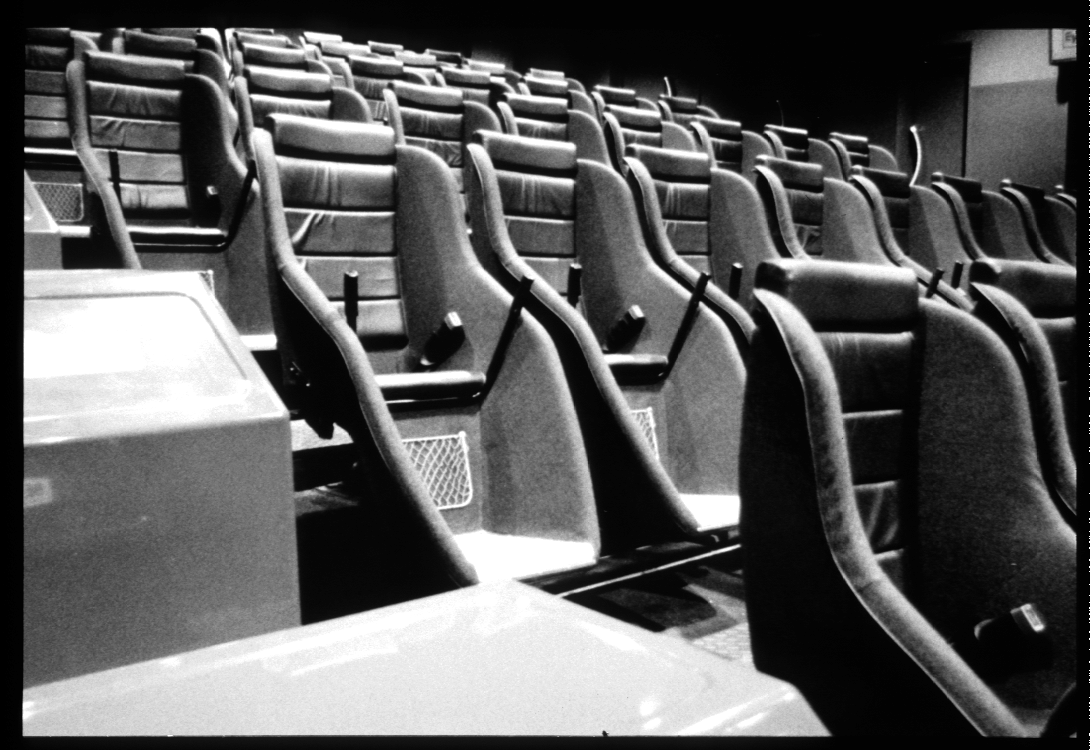

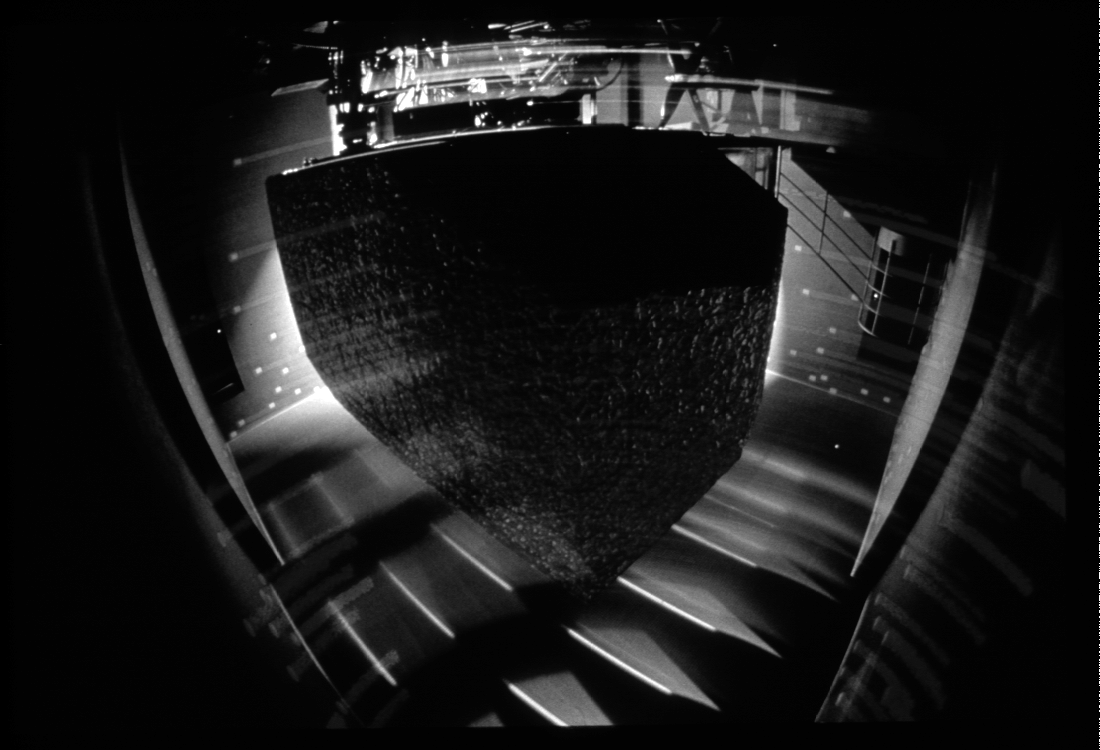
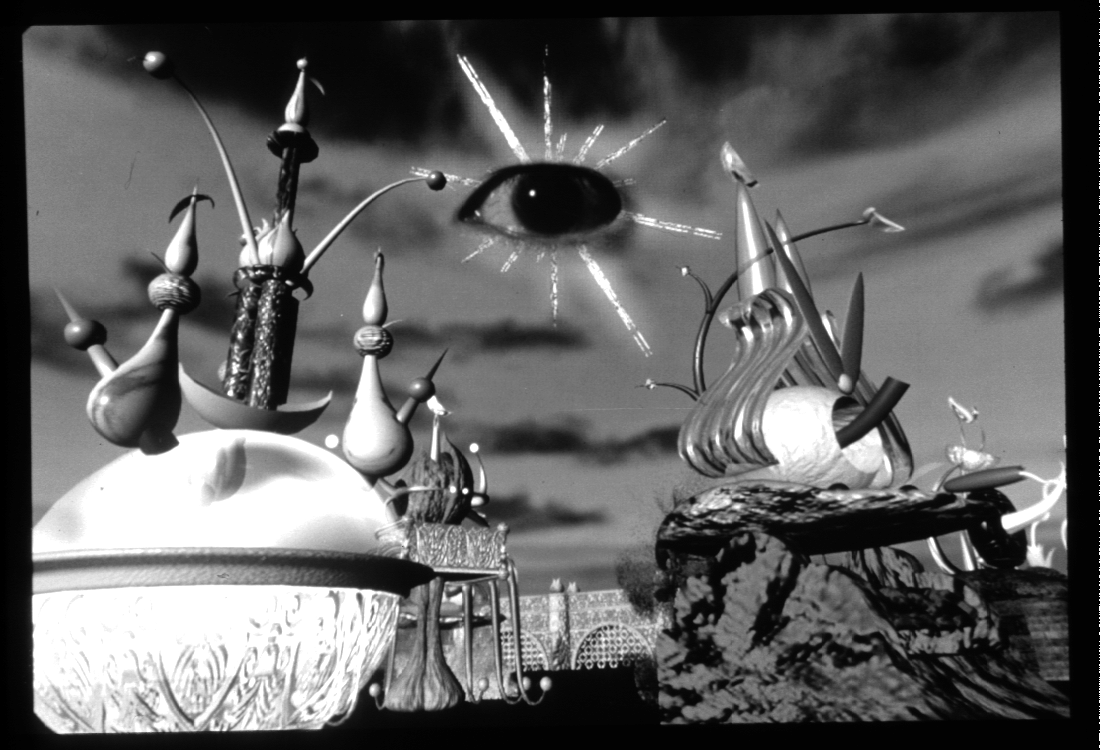

 (Afterwards, notice the rotation/combination chair/tables in the
pavilion.)
(Afterwards, notice the rotation/combination chair/tables in the
pavilion.)
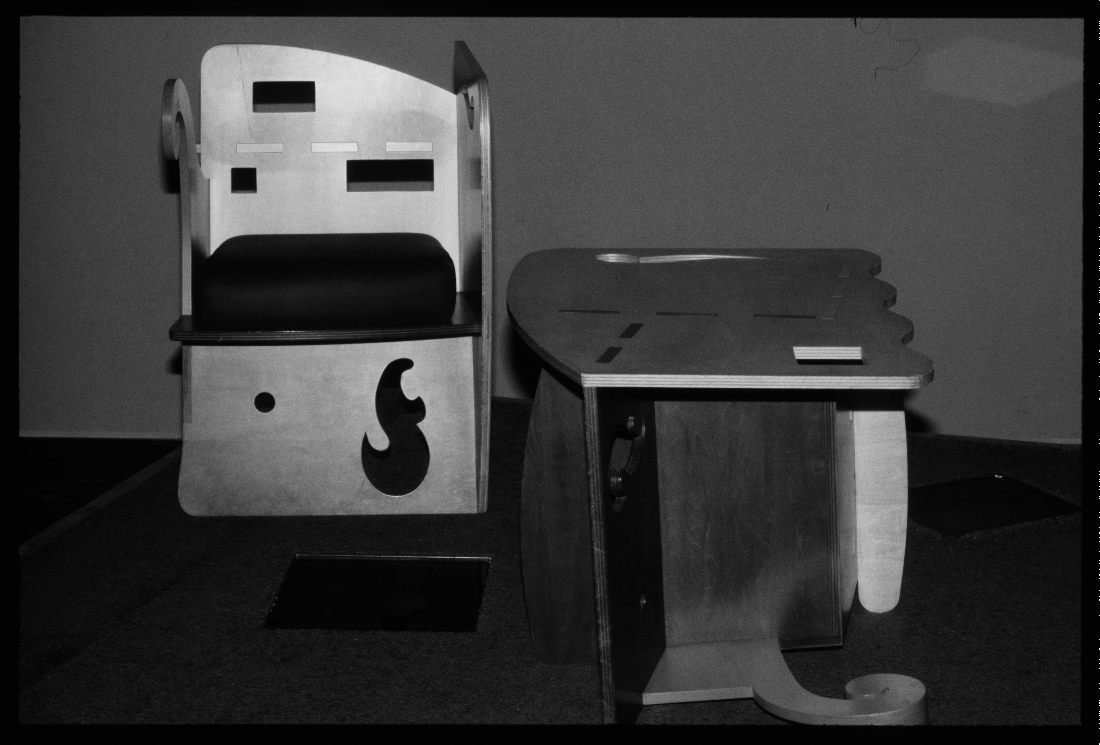
Other local instances of these dynamic auditoria include a Robocop rush at Korakuen's "Hyper Illusion" (next to Tokyo Dome/Big Egg), an absorbing if self-conscious post-apocalyptic space chase at MMLand (for "Motion Master") in Shibuya (enjoy the onomatopoetic manga comics around the building), and a jet-coaster simulation at Virtual Theatre in Shinjuku (with a `beam scan bus' to synchronize the screen, sound, and seats).
Exploring the presentation of seemingly 3D images, and therefore on the fringes of VR, is the JAIB (acronymic for "Jack In the Box") museum. A tribute to the Louvre, the museum features trompe l'oeil (trick of the eye) paintings that leap off the flat panels by faking reflections, detail, and shadows. Visitors are encouraged to photograph and touch the panels, reassuring that they are indeed flat.
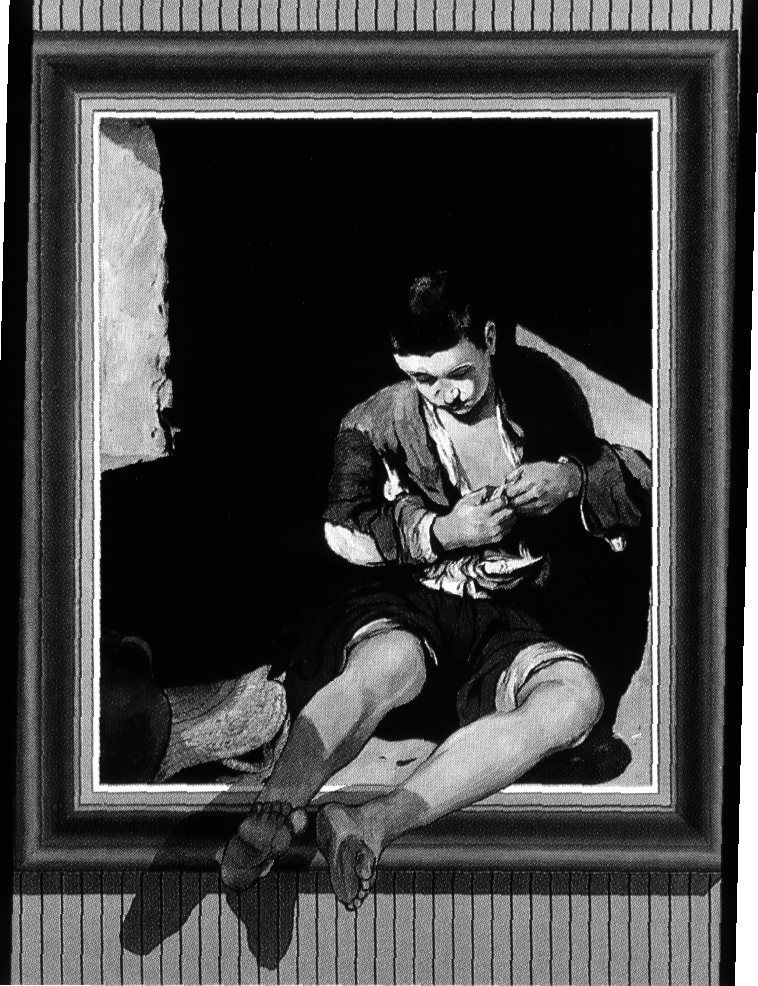
Other venues exploring visual presentation include the Fujitsu Dome Theatre, a 3D Omnimax presentation, projecting both live action and CG (computer graphics) through both anaglyphic and infrared-synchronized LCD (liquid crystal display) actively polarized shutter eyewear. Fujitsu is the manufacturer of the super computers used to model and render the stereographic imagery. (Sit near the projector for least parallax.)
The Tokyo Metropolitan Museum of Photography will be conducting summer workshops on new technologies. Its new building has a special "Visual Contrivance Wing" dedicated to various types of old and new media, from anachromatics to zoetropes.
Tepia (a contraction of "technology utopia") is an exhibition space, with rotating high-tech shows; last year's cycle included Future Human Communication, House of the Future, Robotics, Human in Space, and Advanced Vehicle. Visitors might also be interested in visiting Tepia's permanent (and complementary) video library. Ask for the current list of holdings: mostly educational technology shorts (averaging ~20 min.), including hundreds of English titles. In individual and group booths (some of which have HDTV monitors), enter on the control console the index of the movie you'd like to enjoy, and peek around the corner at the robot jukebox pulling the selected video from the archives and inserting it into the deck.
Sega's "Rail Chase" and Taito's "IDYA" (for "Interactive Dynamic Accelerator") Cybersterra are interactive motion platforms for one or two players. The action scenarios recall, respectively, Raiders of the Lost Arc and Star Wars; the rail/flight paths seem fixed, but paired pilots use weapons (aimed with differently colored cursors on a shared view) to knock out obstacles and attackers, while their vehicle bumps and jumps.
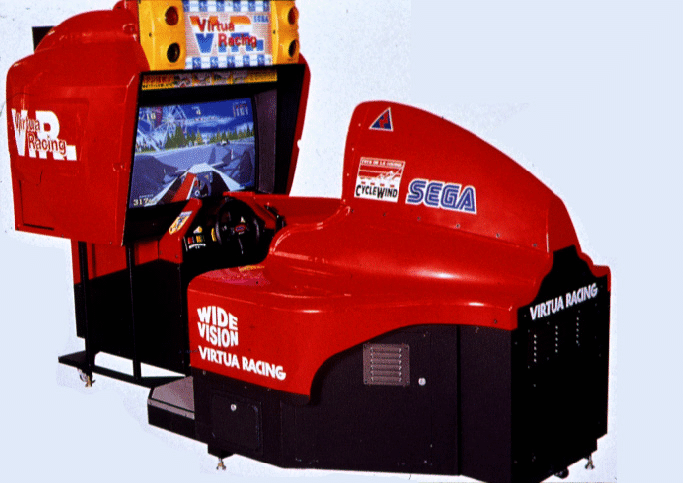
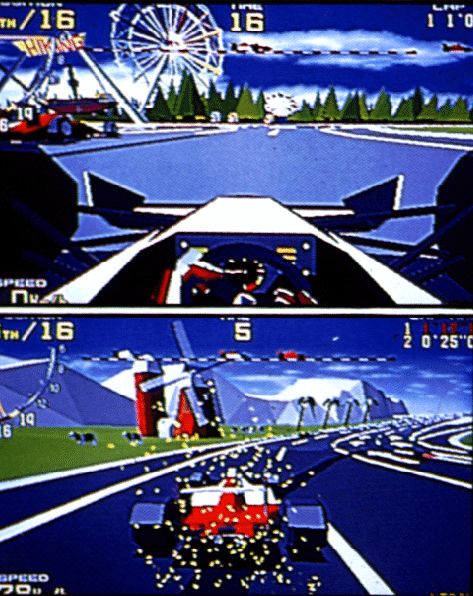 Superimposed translucently is a rotating
orthographic map, with `up' on the map always aligned with `straight' from
ownship, the car's PoV. For extra verisimilitude, motors outside the car
induce yaw, and air-driven suspension bladders inside the cockpit seats
simulate acceleration and collisions. (The force feedback steering recalls
Atari's Hard Drivin'.) Further blurring the sampled/synthesized distinction,
separate monitors for spectators show live video of the drivers, panning shots
of the lead car, static shots of strategic curves, and instant replays of
crashes.
Superimposed translucently is a rotating
orthographic map, with `up' on the map always aligned with `straight' from
ownship, the car's PoV. For extra verisimilitude, motors outside the car
induce yaw, and air-driven suspension bladders inside the cockpit seats
simulate acceleration and collisions. (The force feedback steering recalls
Atari's Hard Drivin'.) Further blurring the sampled/synthesized distinction,
separate monitors for spectators show live video of the drivers, panning shots
of the lead car, static shots of strategic curves, and instant replays of
crashes.
The same 3D/CG liquid perspective also informs Sega's "Virtua Fighter" [still sic]. Two opponents animate puppets from a pool of eight martial artist `vactors' (virtual actors), each with her or his own characteristic kung fu style, verbal struts and victory flourishes. (Impatient humans use the 1P/2P buttons to skip the histrionics.) A single player('s delegate) can fight a computer-driven avatar (a Hindu deity projected into an earthly manifestation, here taken to mean a synthespian in a virtual environment), even pitting (differently garbed) twins against each other, carbon vs. silicon. And, of course, zero humans are needed for computer-animated warriors to fight each other in demonstration bouts.


A common theme in VR is the breakdown of the body as an inviolable entity. Technologies like pulse and brainwave sensors, speech recognition, and body trackers make the human/machine interface more intimate, but no less so than prosthetics (like eyeglasses). Computers are capable not only of AI, artificial intelligence, but also IA, intelligence amplification, extending the mind into cyberspace. While we might be comfortably distant from direct neural connections, it is natural for us to extend ourselves with tools, electronic or otherwise. Japan seems especially receptive to these notions; long before the American Robocop and Terminator, Japan brought forth cyborg pioneers Atom Boy (known as "Astroboy" in America) and Ultraman.
Venté's Watching Radar" has a console which accesses a virtual periscope, a roof-mounted camera, letting users pan and zoom the cityscape. Such (bionic bird's eye) functionality suggests tele-existence (known in the U.S. as telepresence): instead of accessing a computer-modeled or -synthesized universe, tele-existence gives the user a sense of being somewhere else in the familiar universe we call reality. Tele-existence delegates a robot slave to act on behalf of a human master, like bunraku (puppet theatre) with feedback. This delegate can be controlled from afar, the human's various sensors corresponding to the puppet's effectors. Venté has an R2-D2-like telerobot, not autonomous, but piloted by visitors through an adjacent deconstructive microcosmos, the human seeing and hearing what the drone senses, including collision alarms, through stereo sight and sound. Such technology might be deployed in hazardous environments like nuclear power plants, fires, and toxic waste dumps.
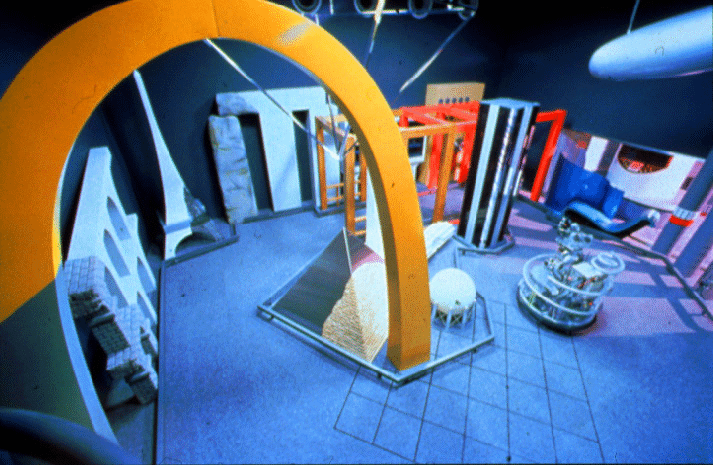
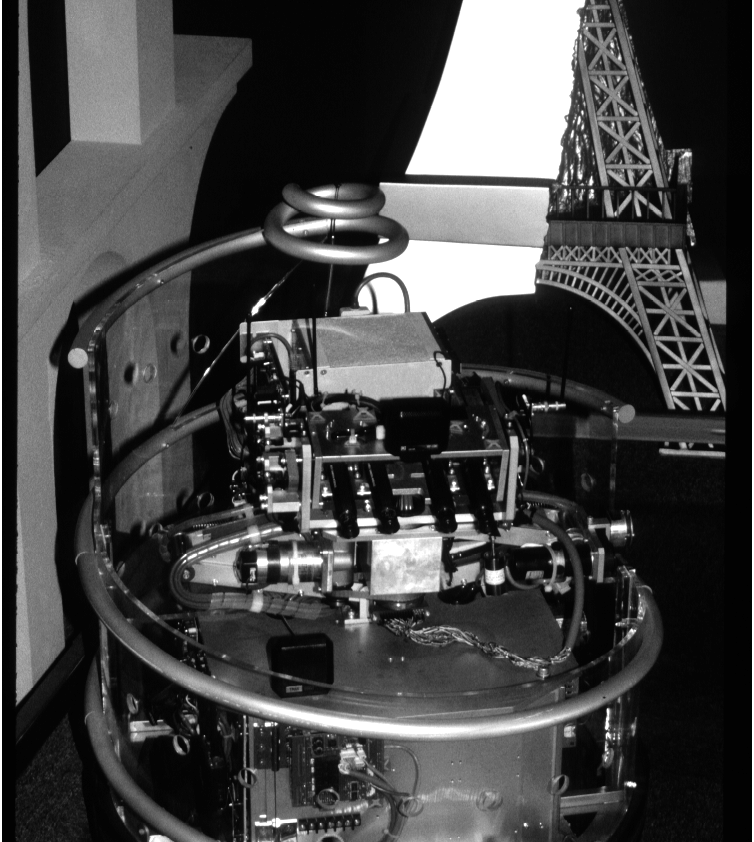
Tepco's (Tokyo) Towerland showcases the potential of electricity, including a telecommunication stage, computer games, and a 3D theatre. (The Tower also has a small but charming holography museum.) Sanrio Gallery, a cloying retail outlet in the Ginza, has an "Echo Well", simulating sound reflections, animatronic robots, and a dioramic candy factory with superimposed animated characters. (Adults with low sugar tolerance can wait around the corner in the Sony building, playing with the newest consumer electronics. New products are typically test-marketed in Japan before being tweaked for export.) While in the neighborhood, detour through "Fantasy Road," a half-alley with UV lights that excite not only phosphorous wall paintings, but also detergent-washed underwear.
Turn a long shot into a big shot: While Dad's at the track, the rest of the family can visit the JRA (Japan Racing Association) Racing Museum. "Riding Vision" simulator puts junior astride a galloping steed, thundering down the homestretch to the accompaniment of grandstand cheers. "Riding Simulation" fields 8 against each other: (computer-mounted) jockeys slap their horseshoes to propel their mounts around the circuit.
Amazing Square is a /dato-supatto/ (date spot) theme park. Besides carnival rides, superheroes, and the "You are the captain" maze, there's "Laser Warrior," a couple-wise walk-through shooting gallery. Teenagers of all ages can enjoy synesthesia, the perception of one sense modality through another. In "Beam Chaser," adventurers wearing light-sensitive headsets creep through a funhouse that shoots rays of light which trigger audio alarms.

Another theme park with a high otaku-factor is Namco Wonder Eggs,
featuring the front wave of arcade games, all elaborately staged.
(Otakus, colloquially, are individualistic fanatics, typicall adolescent
males, passionate to the point of obsessiveness about a particular subject,
like computers or war games, to the detriment of normal social skills; an
approximate english translation is "geek.") A favorite attraction is
"Galaxian3", descendent of the once-ubiquitous video game. (The
superscript refers to the spatial dimensionality; perhaps the original should
have been called Galaxian2, but there is none.) 32 star fighters
sit at consoles arranged in a circle, facing outward to a shared 360 degree
panoramic screen. As enemy warships attack, the mother ship pitches and rocks
against the interactive onslaught.


Up the street from Shibuya's MMLand is Dr. Jeekahn's, named for the mysterious
holographic Tomaru Jeekahn ("stop time"), a 6-story tower of upscale
entertainment. While the upper floors house a casino, restaurant, and club,
Dr. Jeekahn's also has several attractions appreciated by the star-fighter set.
The most challenging is Battletech, another distributed (networked multiplayer
=> groupware) game and a franchise of the Chicago-originated "location-based
entertainment," pitting teams of seductively accessorized Mechs (armored
warriors) against each other. Fighter-configurable cockpit weaponry, advanced
instrumentation, and sophisticated controls (like night vision, infrared, and
IFF-- identify friend or foe) make this interactive
simulator popular for repeat defenders.

Across the street is Sigma's Rongo Rongo (incongruously named after the language used on Easter Island), featuring another Battletech installation upstairs. In Japanese arcades, the games with the highest number of simultaneous players are racing simulations, for wagering tokens on miniature horses, cars, and speedboats. Rongo Rongo downstairs has a generous thoroughbred track: 36 players (not counting kibitzers) sit around a grandstand at personal gambling stations. Like most spectator sports, after the betting stops and the race begins, there is limited interaction between the audience and the sportsbeings, excluding telekinetic effects, and the results are (presumably pseudo-)random. Parimutuel systems are bound to increase interspectator interaction.
Matsushita is a keiretsu, a giant umbrella corporation, that includes brandnames National and Panasonic. Putting kitsch into the kitchen, Matsushita's Home Showroom features a goggles 'n' glove system (EyePhone/Dataglove), allowing customers to enter a self-arranged virtual kitchen, test-driving their layouts ("design for lifestyle"). One day a week the general public is invited to try this ¥ 1 oku (hundred-million yen » $1 million) system. Walking through the room, take virtual plates (flying saucers) out of the cabinet and put them under the tap's running water. Move the (Convolvotron spatial audio) radio to the other side of the cartoon counter.
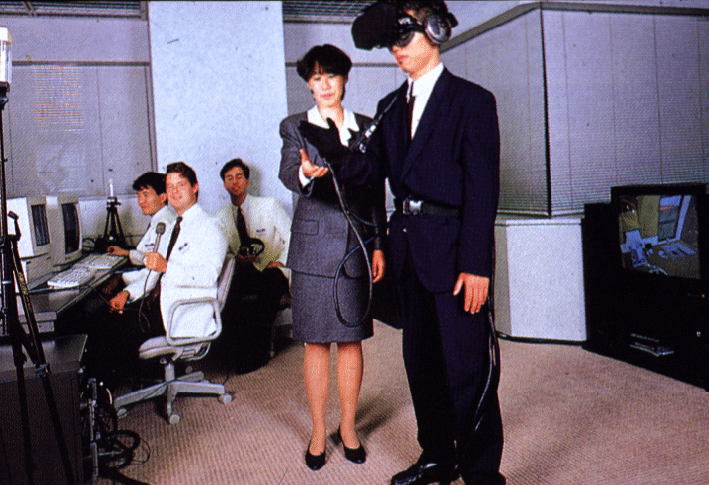
"Sex, drugs, and rock & roll" can be thought of as pleasures of the body, mind, and soul. And Japanese seem to want them virtual, no less-- a holo-trinity: post-modern analogs of wine/women/song, and the collective epitome of self-indulgent technofun. Even hedonists are citizens, though, and accommodation is the very essence of virtual reality. If the body of VR is hardware (the sensors, effectors, robots, and communication networks), and its mind is software, then its soul is the intersection of science and art, the threshold between discovery and invention, the blurring of nonfiction and fiction. But consumers don't want metaphors; they want cybervixens, legal Alice-in-Wonderland "Get Outside of Me"s, and newer age music. Karaoke/hostess bars to turn on as well as into. Joys in the joystick and love in the dataglove.
Two examples of telephone-enabled diversions seem uniquely Japanese: Instead of maintaining large private libraries of laser disks, karaoke machine clients here can call a music server and use ISDN to download MIDI songs, which are rendered locally by synthesizer. "Two-shot" telephone/video clubs are singles clubs with a curtain of technology: male and female patrons are seated in separate rooms, but call each other via individual video phones. If there's a pick-up without a hang-up, newly paired couples can arrange to leave together, perhaps to a nearby love hotel.
Japan is very strict about controlled substances, perhaps encouraging (fully crossed) {"Virtual", "Video"} x {"Drug", "Trip"} packages: 3D psychedelic images, sounds, and incense designed to stimulate and relax. Available at Wave as well as Roppongi specialty shops Bo Peep and Whoopee (between the waterpipes and holograms, next to the brain synchronizer), some of the sets include special prismatic glasses that enhance the kaleidoscope nature photography.
While every attempt has been made to ensure the accuracy of this information, calling ahead to confirm hours of operation is suggested. Unless otherwise noted, all addresses are in Tokyo, with phone prefix (03).
name. station. price. open hours. address. phone.
Amazing Square . Tobu Isesaki: Ushida or Keisei: Sekiya. ¥ 2500. Mon.--Fri. 10:00--17:00, Sat.--Sun. 10:00--18:00. 19-1 Senjusekiya-cho, Adachi-ku. 3882-8011.
Bo Peep. Hibiya: Hiroo and Roppongi. Yamachu Kasumicho Bldg. 1F, 3-24-19 Nishi-Azabu, Minato-ku. 13:00--04:00 (for post-club shopping convenience). 5410-4144.
Toyota Amlux. JR: Ikebukuro, across from Sunshine City. Free. Tues.--Sat. 11:00--20:00; Sun. & holiday 10:00--19:30; Closed Mon. 3-3-5 Higashi-Ikebukoro, Toshima-ku. 5391-5900. http://www.toyota.amlux.co.jp/Amlux/index.html
Tokyo Disneyland. JR Keiyo: Maihama. Passport: ¥ 4800. 1-1 Maihama, Urayasu-shi, Chiba-ken. 0473-54-0001
Fantasy Road. Higashi Ginza. Free. Open all the time, but go after dark. Between Togeki Bldg. and Ginza Tokyu Hotel, 4 Tsukiji (across from the Kabuki theatre).
Fujitsu Dome Theater. JR Keiyo: Kaihin Makuhari. ¥ 1200. 13:30--18:30 plus special shows. 1-9-3 Nakase Mihama-ku, Chiba-shi. 043-299-3215.
Game Fantasia. Various branches, including Shibuya. 13-11 Udagawa-cho, Shibuya-ku. 10:00--24:00. 3496-5856.
Sega GIGO. Ginza subway: Roppongi. Virtua Racing (F1 simultor): ¥ 300; R360 (fighter airplane simulator): ¥ 500; Virtua Fighter: ¥ 200. 15:00--23:00. 7-14-4 Roppongi. 5474-0789.
Jaib Museum. Toei Shinjuku: Mizue. ¥ 800. 10:00--19:00. 6-136 Shinozaki-cho, Edogawa-ku. 3678-9966.
Dr. Jeekahn's. JR: Shibuya. Battletech: ¥ 1000/battle, Venturer: ¥ 500. Mon.--Fri. 15:00--23:00; Sat. & Sun. 11:00--23:00. 2-4 Maruyama-cho, Shibuya-ku. 3476-7811.
JRA (Japan Racing Association) Racing Museum. Keio: Fuchukeibaseimonmae, Higashi-fuchu, JR: Fuchu-honmachi, or Seibu-tamagawa: Koremasa. Free. Wed.--Fri. 10:00--16:00; Sat. & Sun. 09:00--16:30. Tokyo Keibajo (Horse Track), 1-1 Hiyosi-cho, Fuchu City. 0423-63-3141.
Korakuen Yuenchi. JR or Mita: Suidobashi or Marunouchi: Korakuen (next to Tokyo Dome- Big Egg). Ticket set (good for 10 amusments, including Geopanic, Zombie Paradise, and Hyper Illusion): ¥ 3200. 10:00--22:00. 1-3-61 Koraku, Bunkyo-ku. 3817-6098.
Matsushita Electric Works Kitchen Showroom. Shinjuku. Free. Open to public only on Mon. 13:00--17:00, reservations required (about 3 weeks in advance). 4th Floor, Monolith (pronounced "Mona Lisa") Bldg, Nais Plaza; 2-3-1 Nishi-Shinjuku, Shinjuku-ku. 5381-8211.
MMLand. Shibuya. ¥ 1000. Mon. 13:30--23:30; Tues.--Thurs. 13:30--23:00; Fri. 13:30--23:30; Sat., Sun. 10:00--01:00. 1-8 Maruyama-cho. 3476-6325.
Sigma's Rongo Rongo. Shibuya. Battletech: ¥ 2000 for three round introduction. Mon.--Fri. 16:00--23:00; Sat., Sun., & holiday 13:00--22:30. 2-21-7 Dogenzaka, Shibuya-ku. 5458-6565.
Sanrio Gallery. (closed)
Taito Inn Stadium. Shinjuku. IDYA Cybersterra: ¥ 300/one player, ¥ 500/two. 1-21-7 Kabuki-cho. 3200-8085.
Tepia. Ginza subway: Gaienmae. Free. Closed Mon.; Tue.--Fri. 10:00--18:00; Sat, Sun, & holidays 10:00--17:00. 2-8-44 Kita-Aoyama, Minato-ku. 5474-6111. http://www.tepia.or.jp
Tokyo Metropolitan Museum of Photography. Hibiya or JR: Ebisu. ¥ 200. 10:00--18:00; closed Monday (Tuesday if Monday is a national holiday) and from December 28 to January 4 4-19-24 Ebisu, Shibuya-ku. 3280-0099. http://www.tokyo-photo-museum.or.jp
Tokyo Tower. Teoi Mita: Shibakoen or JR: Hamamasucho. Tepco: Free. Sun.--Sat. 10:00--17:00; Closed last Wed. of month. 4-2-8 Shibakoen, Minato-ku (across from Darth Vader's summer cottage). 3437-1712.
Virtual Theatre. (closed)
Fujita Venté. Free. JR: Yoyogi or Sendagaya. 4-6-15 Sendagaya, Shibuya-ku. 10:00--18:00, closed Thurs. 3796-2486. http://www2.fujita.co.jp/vente/
Nameco Wonder Eggs. Futako-Tamagawa-en. Entrance: ¥ 800; Galaxian3: ¥ 600; Future Colloseum: ¥ 600; Ridge Runner: ¥ 200; Virtual Vehicle: ¥ 500; Phantomers: ¥ 300. 10:00--22:00. 1-15 Tamagawa, Setagaya-ku. 3700-3451. Closing 28.2.98.
Whoopee. Hibiya subway: Hiroo and Roppongi. 2-25-19 Nishi-Azabu, Minato-ku. 13:00--04:00 (aprés club). 3400-1963.
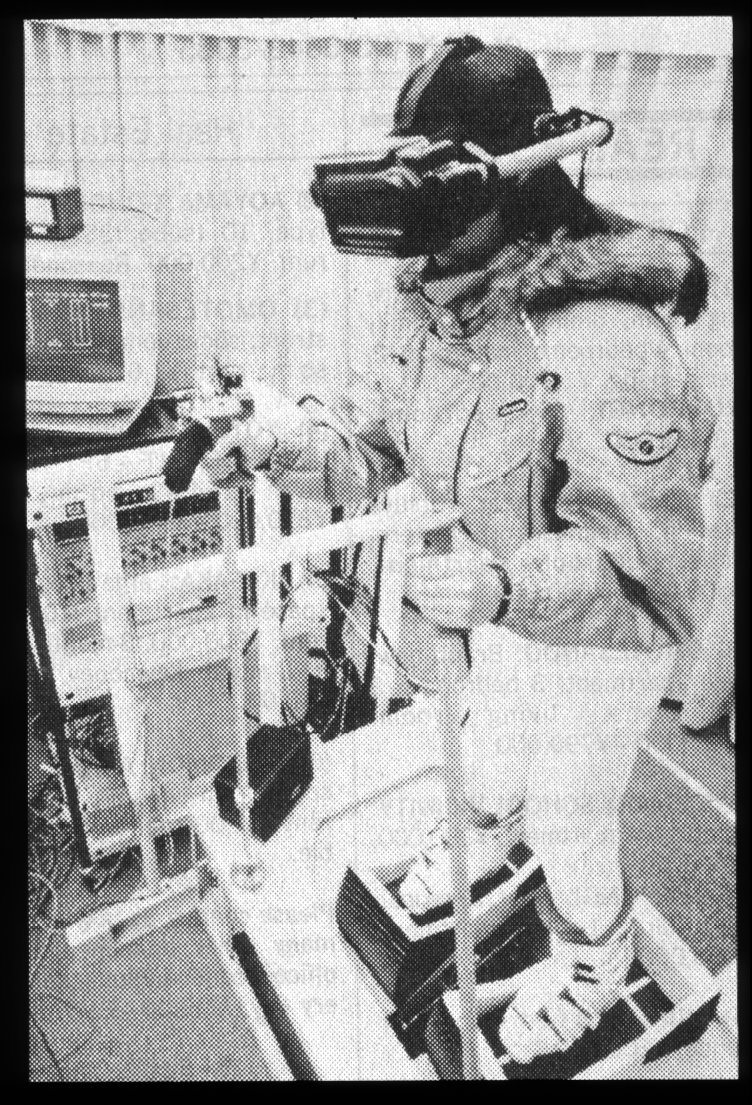
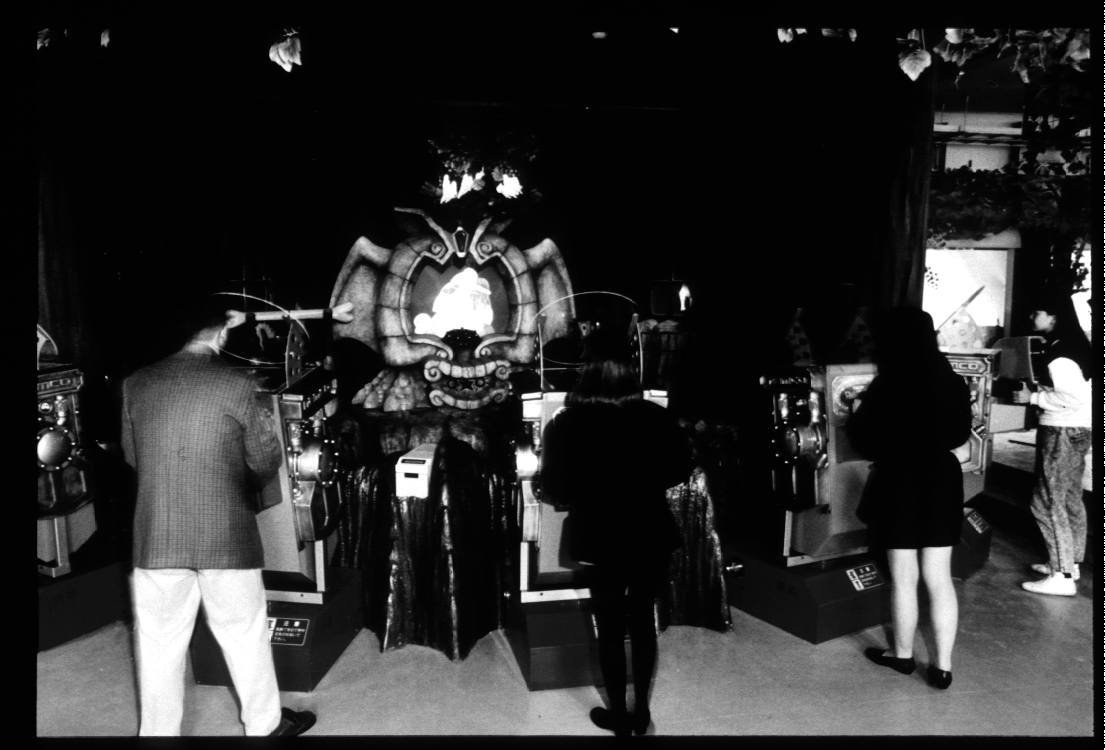
References